12 Benefits of Ustrasana & How to Do It?
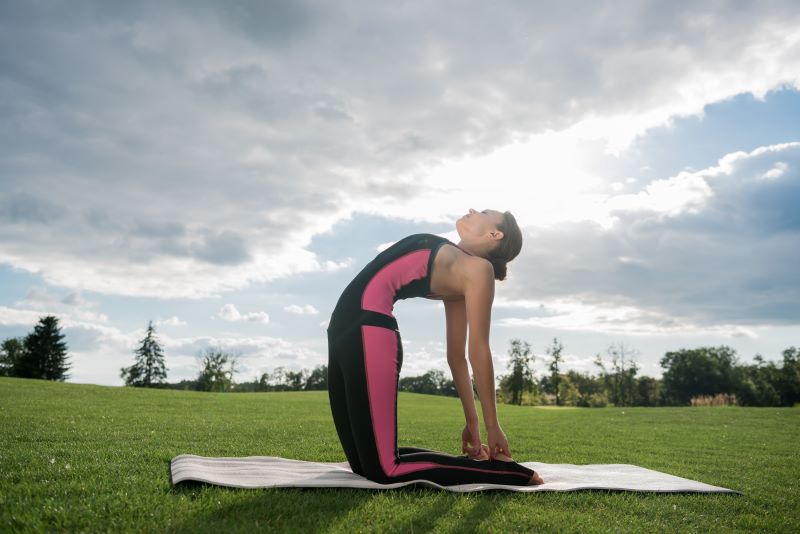
Ustrasana, or camel pose, is a famous asana in yoga that affects the body and mind very significantly. It has numerous advantages including; muscle flexibility, good posture and relief from stress which increases body energy.
Whether you are an old yogi or somebody who just started practising it, Ustrasana can improve your vitality. Find out how this powerful pose can change your life forever, and know how to perfect it with calmness and lightness.

Table of Content

What Is Ustrasana or Camel Pose?
Ustrasana, often known as the camel pose, is a simple yoga asana to activate the heart chakra or Anahata. Therefore, people who desire to increase their strength and flexibility can benefit from it.
Ustrasana is beneficial for people with poor digestion as well. It is an intermediate-level backbend practice, but a few details must be examined to ensure it is done correctly.
How to Perform a Camel Pose (Ustrasana)?
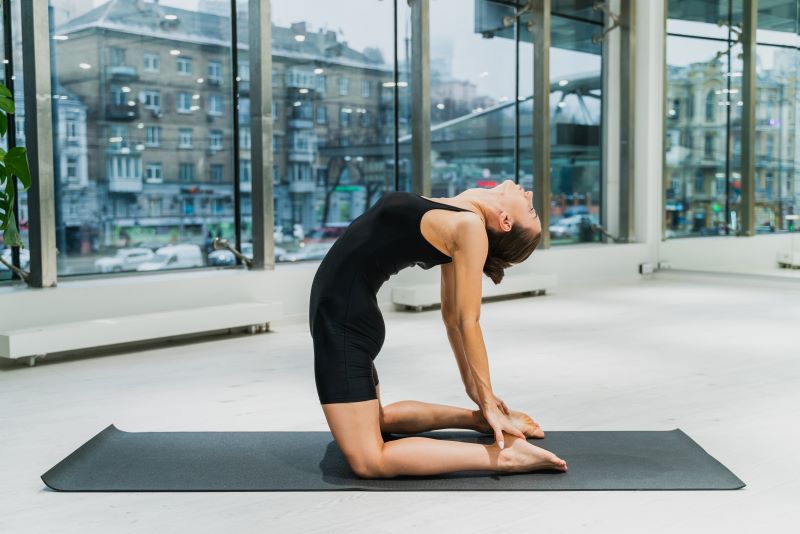
Ustrasana stretches the front body and strengthens the back. Discover how to safely practise this asana by following these steps:
Step 1: Start by kneeling on your yoga mat with knees apart at hip-width distance. Make sure the tops of your feet are pressing firmly on the mat.
Step 2: Position hands on lower back, palms facing down, with thumbs resting on sacrum for support.
Step 3: Breathe in deeply as you slightly curve your spine upwards, raising your chest towards the roof of the mouth and drawing back together the blades of your shoulders.
Step 4: As you lift your chest, keep reaching back to grab onto your heels. You can also place your hands at hips or extend them toward the lower back instead.
Step 5: Push forward with your hips while tightening your glutes and lifting your chest towards the ceiling to achieve a profound backbend. Elongate the neck and let it relax without any strain.
Step 6: Hold this pose for 20 to 30 seconds while maintaining steady breathing. With every breath in, let go more deeply into the stretch while lengthening the spine and expanding the chest during inhalation breaths.
12 Health Benefits of Camel Pose
The top benefits of Ustrasana are as follows:
1. Spinal Flexibility
The camel pose involves bending over backwards and stretching the spine to increase its flexibility, relieve stiffness, and enhance a greater range of motion.
2. Improved Posture
Practicing this pose often strengthens the back muscles, aligning the body in a better posture such that back pain is relieved and general body mechanics improved.
3. Stimulated Digestion
The asana actually encourages peristalsis (the movement of food through the digestive system) to deal with bloating, gas, cramping, or constipation caused by poor digestion.
4. Back and Core Strength
Involving muscles while performing this asana increases spinal stability and core strength. This greatly helps to prevent injury cases that may happen during athletics.
5. Leg and Glute Activation
This particular posture works out the hamstrings, glutes, hips, and quadriceps because all these muscles are at work during the camel pose. It helps build lower body fitness, making the lower body more stable for better balance and preventing falls.
6. Stress Reduction
The camel pose can help reduce stress levels while keeping one calm by inducing deep breaths coupled with relaxation. It is also helpful if suffering from anxiety.
7. Chakra Activation
Camel pose stimulates the heart chakra, promoting balance and harmony in the energy body, aiding emotional healing and spiritual growth. The openness creates a sense of physical comfort and makes one feel emotional well-being.
8. Boosted Pranic Flow
The camel pose amplifies prana flow through the body, re-energising it and enhancing its vitality. Awareness of prana leads to healthier and more fulfilled lives.
9. Enhanced Lung Capacity
Expanding the chest and lungs increases lung capacity and respiratory efficiency, enabling better blood oxygenation and improved endurance. Regular practice is also essential for most benefits.
10. Deep Breathing
A good example is camel posture, which encourages deep, diaphragmatic breathing. This helps decrease stress levels, improve mental focus, and promote relaxation. It is also essential to enhance lung capacity.
11. Increased Blood Circulation
This posture aids blood flow to the heart and essential organs, thus boosting blood circulation. It improves cardiovascular health, reducing the chances of developing heart illness.
12. Controlled Blood Pressure Levels
Regularly doing Ustrasana, which expands the chest, may help control high or low blood pressure. It also supports cardiovascular function, resulting in healthy hearts.
Mudras of Ustrasana
Ustrasana can be made more energetic and profound by using mudras or hand gestures. The following are some mudras that can be used during Ustrasana:
1. Anjali Mudra (Prayer Position)
Begin this pose by placing the hands together in a prayer position at the heart. As you open your chest and reach back into a backbend for camel pose, keep the touch of your fingers in line with the heart.
Benefits of Anjali Mudra: Anjali Mudra encourages better concentration and deliberation, mingling one’s mind with one's yoga poses.
2. Gyan Mudra (Gesture of Knowledge)
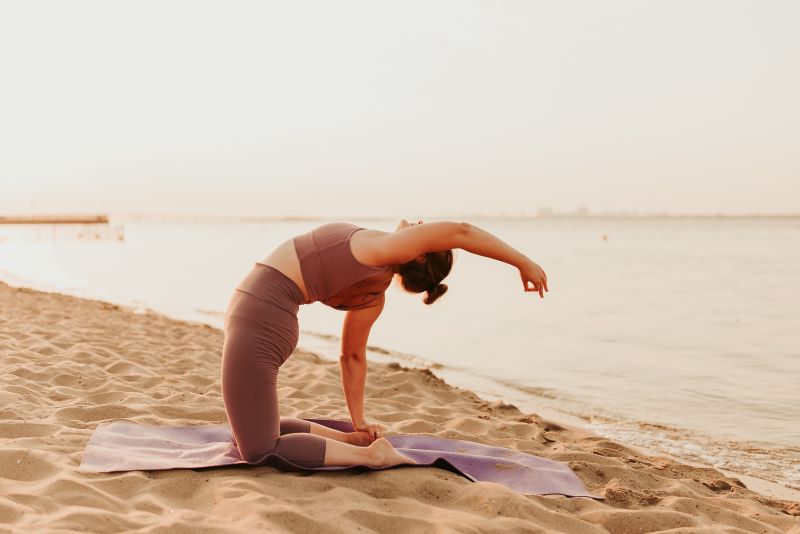
Start this posture by creating a mudra with your hands. Still, when lifting your chest and reaching backwards, one hand stretches out with your index finger touching your thumb and the other holding your feet.
Benefits of Gyan Mudra: Gyan Mudra allows you to have a clear mind as you approach this asana.
3. Moksha Mudra
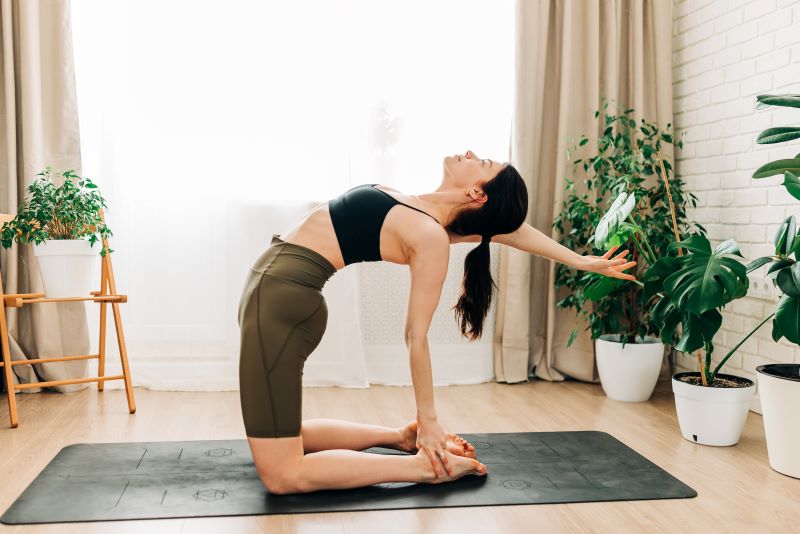
Lay your hands behind the body in preparation for the camel pose. Once again, as you raise your chest and stretch backwards, hold onto the palms while encouraging surrendering, and one hand is stretched out, giving a deeper backbend.
Benefits of Moksha Mudra: Moksha Mudra helps detoxify and enhance concentration and spiritual growth.
Types of Ustrasana
Different Ustrasana poses have different options and degrees of intensity for all kinds of practitioners. Below are some common types:
1. Standard Ustrasana (Camel Pose)
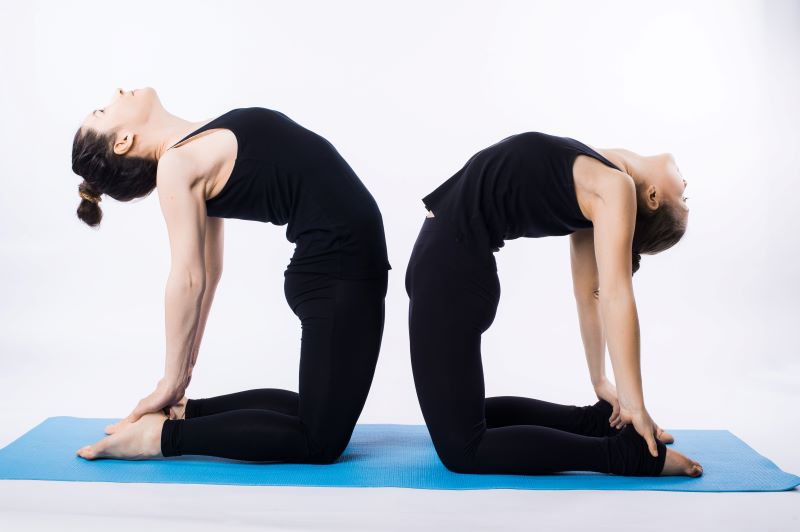
In standard Ustrasana, the yogis kneel with their knees hip-wide apart, creating an arch in their backs. They reach for their heels with their hands, resulting in a deep backward bend.
2. One-Legged Ustrasana (Eka Pada Ustrasana)
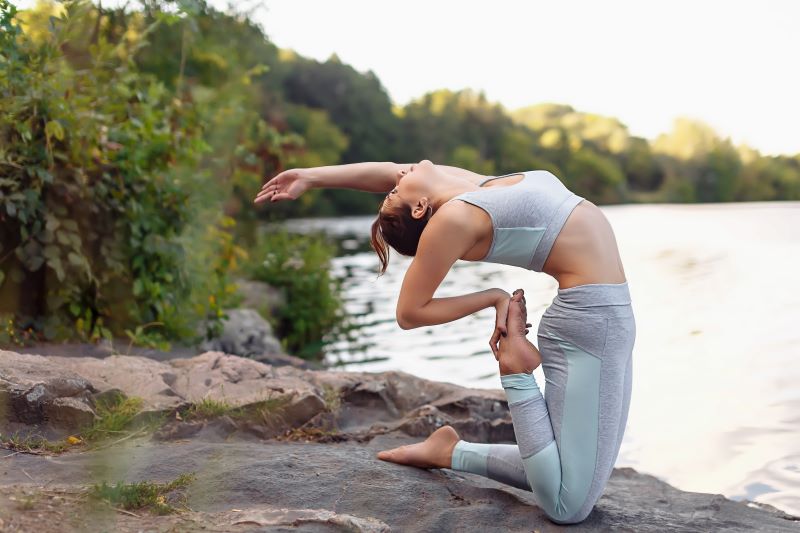
In this variety, one leg is lifted off the floor while in camel pose, leading to increased stretch through the front of the body and activation of core strength and balance.
3. Arm Variation (Urdhva Dhanurasana in Ustrasana)
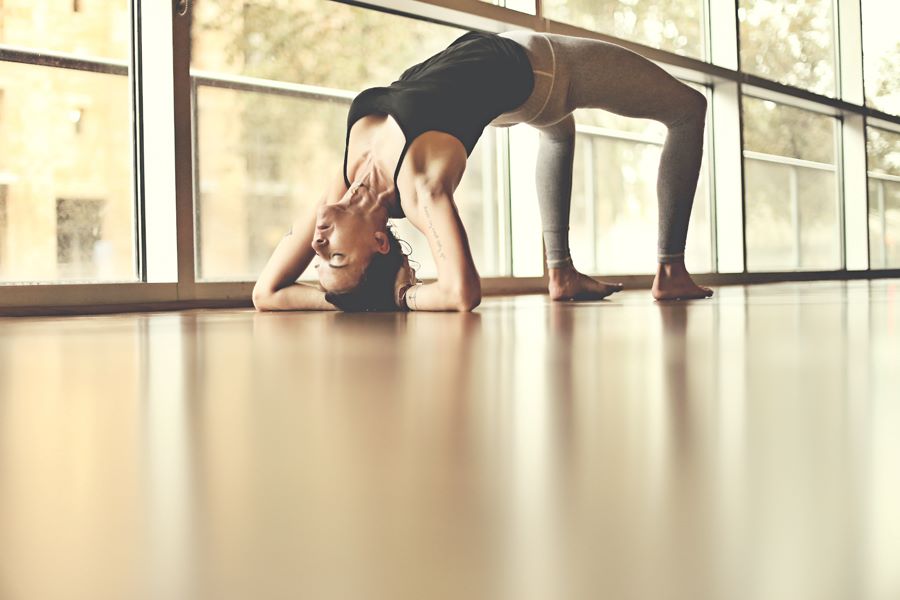
They put their palms on either side of their feet and lift the chest and hips, moving from here into a deep backward bend resembling an upward bow pose (Urdhva Dhanurasana).
4. Reclined Ustrasana (Supta Ustrasana)
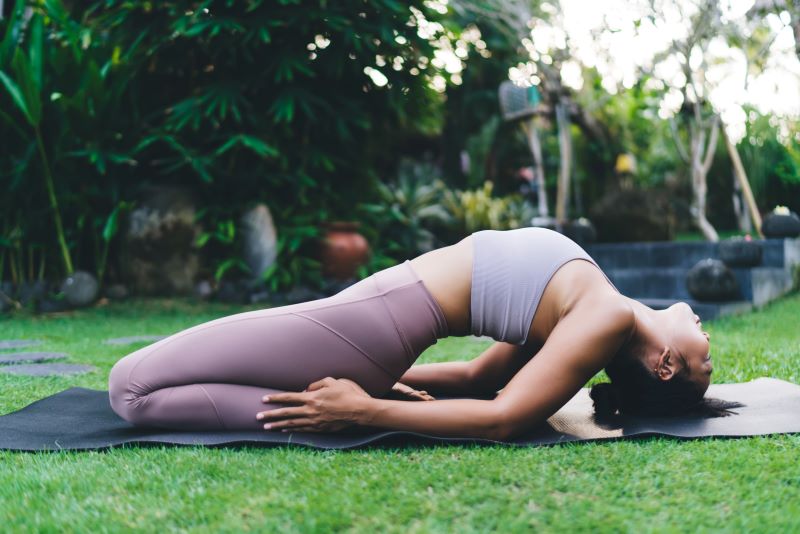
Practitioners entering Supta Ustrasana lie back onto their forearms or to the ground, giving them a gentle backward curve when lying supine.
5. Chair Ustrasana
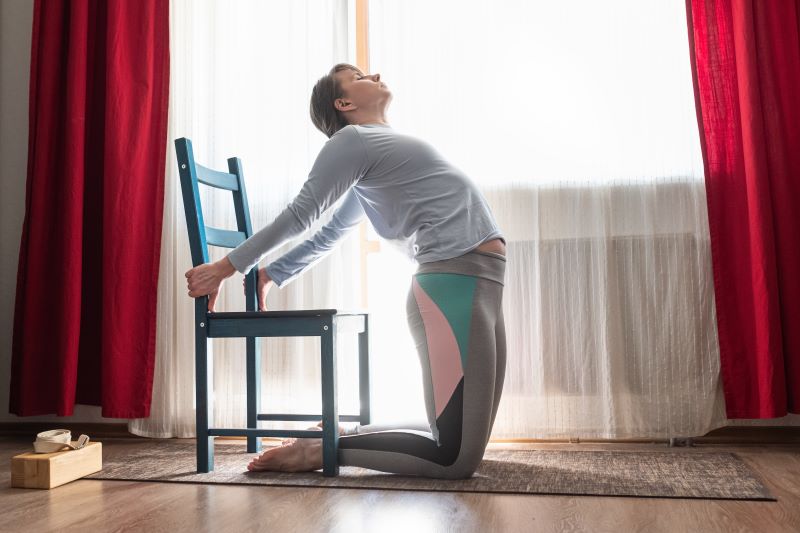
Practitioners can also perform this pose while holding onto a chair for support by placing their hands at the edge of the seat to get into the backbend. This makes it possible for people who cannot stretch much due to age or accidents.
Things to Know Before Doing Ustrasana
Before attempting Ustrasana, you must consider key factors to ensure that you have a safe and effective practice.
- Warm-Up: Before you start, do some gentle stretches to loosen muscles. This will help prevent strain and optimise flexibility.
- Listen to Your Body: Whenever discomfort arises during the exercise, pause or modify your movements according to the signals emitted by your body.
- Practice on Empty Stomach: Avoid eating right before it so that stomach discomfort or any digestive issues won’t ruin your experience.
- Use Props: Blocks or other props will help support your pose, making it more accessible and comfortable and allowing you to explore it without risk of injury.
- Breath Awareness: While in this position, practice steady breathing. It boosts both mind and body, helping establish a stronger relationship.
How Long to Sit in Ustrasana?
It’s hard to state the exact time a beginner should hold Ustrasana because it depends on how strong and flexible they are:
- Beginners: Beginners should hold the pose for about 10 to 15 seconds at first. Focus on staying in line and breathing deeply throughout the exercise. With time, when you feel more comfortable in your body, try holding on to Ustrasana for 20 to 30 seconds.
- Intermediates: Intermediate practitioners can maintain the posture correctly for longer periods. Stretch more, plunging into the posture and practise continuous breathing while holding the Ustrasana for 30 to 45 seconds or even longer.
- Advanced Yogis: In advanced practice, try to hold the pose for at least 60 seconds or more, focusing on refining alignment, deepening the backbend, and exploring variations. They may hold the pose for shorter durations within the context of a larger sequence.
Risks of Overdoing Ustrasana
Though Ustrasana has excellent benefits to both mind and body, but doing this back bending excessively can result in possible dangers and complexifications.
- Neck and Spinal Strain: A hyperextending neck or lower back can strain the lumbar region and cervical spine, which may cause pain or injury.
- Compression of Vertebrae: Overbending of the spine unconsciously produces a narrowed vertebral space, resulting in disc herniation or spinal misalignment.
- Knee Discomfort or Injury: Forcing the knees to reach for heels might result in knee joint problems, primarily in individuals with pre-existing conditions.
- Shoulders and Wrists Strain: Incorrect arm alignment when holding Ustrasana can injure either shoulders or wrists, making them painful areas.
- Breathing Difficulties: Breathing is restricted, and tension in the chest makes deep breathing difficult, resulting from overexertion in Ustrasana.
- Increased Blood Pressure: A temporary rise from a powerful backbend of Ustrasana may put those with high blood pressure at risk.
- Muscle Soreness or Fatigue: Going too far without being ready may make muscles sore, tired, or overstressed.
Important Tips for Practising Camel Pose?
Here are a few tips for practising camel pose for you:
Since placing the instep (top surface of the foot) flat on the floor initially feels challenging, you can tuck your toes under. This will make it easier for you to stand up and put your hands on your ankles.
To get comfortable, beginners can tuck a folded blanket under their knees.
To start, you can put yoga blocks next to your feet under your hands to give you more height to place your hands.
Perform this pose initially with your knees and thighs fastened to a wall in front of you. You will find that doing this greatly aids in maintaining good posture.
What are the Precautions and Contraindications of the Camel Pose?
Follow these precautions and contraindications while performing the camel pose to avoid any chances of injury:
Being aware of your body's limitations is crucial when doing this asana. Avoid overstretching your body because doing so might lead to injury.
Camel Pose should not be performed if you have a recent or severe injury to your spine, core, thighs, knees, shoulders, or feet.
Avoid doing this pose if you have high or low blood pressure, migraines, or insomnia, or consult a professional before doing it. In these circumstances, this asana's tilting of the head and neck can be harmful since it alters the blood flow.
Ustrasana should be done slowly and carefully. Inadequate performance can result in harm.
Who Should Avoid Ustrasana?
Despite the many advantages of Ustrasana, its practice should be approached with caution or avoided altogether because of certain health conditions or issues.
- Neck or Back Injuries: The severe back bend in Ustrasana can worsen injuries, including fractures and herniated discs, both current and chronic.
- Blood Pressure Issues: Ustrasana can temporarily affect the levels of arterial tension, causing fluctuations in blood pressure.
- Heart Conditions: If a person’s heart has issues, they may put themselves under increased stress, leading to increased blood pressure while exercising.
- Pregnancy: The deep backward bending posture in Ustrasana can cause abdominal compression, which might create discomfort or complications for pregnant women.
- Knee or Hip Problems: Extreme injuries or issues in these regions may become aggravated by the force exerted on them during Ustrasana.
- Recent Abdominal Surgery: Intense stretching could strain healing tissues, leading to risks during the post-surgery healing process.
- Vertigo or Balance Issues: Dizziness and confusion are possible due to performance, which increases the chances of tripping over and causing damage to oneself.
What are the Easy Modifications of a Camel Pose?

Since camel pose might be difficult for some to master, here are some modifications that can be of help:
Place your Hands on the Lower Back: To receive the benefits from this stretch, you can try placing your hands on your lower back if you find it challenging to bring your hands to your heels.
Use Cushions/Blankets as Support: You can use cushions or a thick blanket to support your knees and gain extra confidence.
Use a Wall as Support: As a beginner, you can try a camel pose against the wall. For that, you need to kneel with your knees, thighs and pelvis against the wall. Use the same principle for your fists and lean back. This will help align the hips to remain above the knees.
Use a Chair: You can also use a chair as a modification. However, for this, you need to place your hands on the chair behind you instead of your ankles.
Use Blocks: The use of blocks does another modification for this exercise. However, blocks are not as stable as chairs and might be difficult to lean on.
Now that you know the health benefits of camel pose, start practising it from today itself. You can dedicate a 15-minute break in between your work hour shifts for this, and you will thank yourself later.













